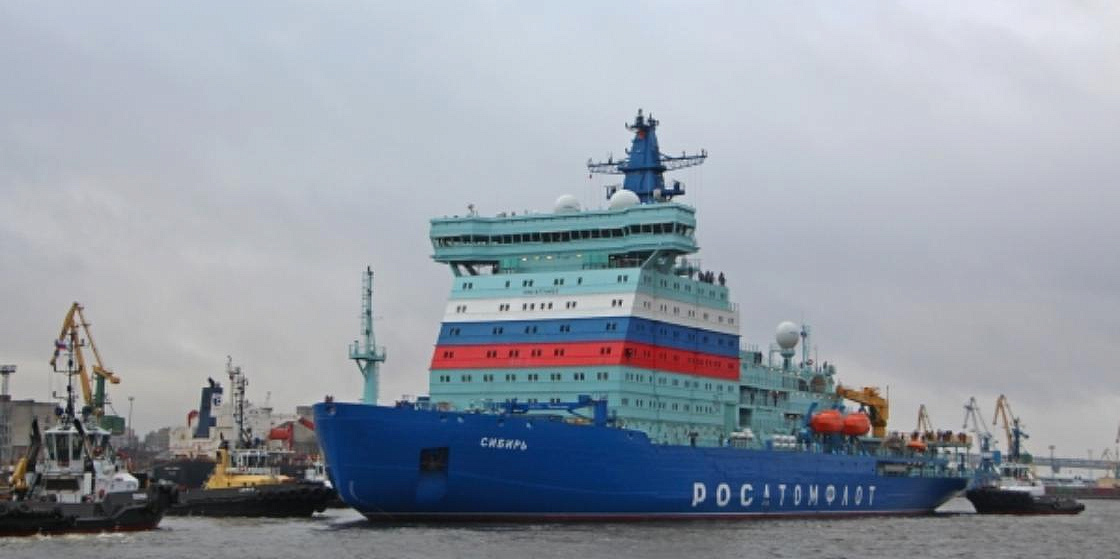
Siberia Is Heading to the Baltic for Trials
Steps are being taken to further increase the Russian icebreaker fleet in the Arctic. On 16 November, nuclear-powered icebreaker Sibir (Siberia) left the Baltic Shipyard in St. Petersburg for running trials to be staged in the Gulf of Finland and the Vyborg Bay. In the course of three weeks, a team of experts will be running tests aiming to find out how all the ship’s systems -- engines, steering gear, navigation, communication and geopositioning systems etc. -- are performing.
Upon completion of these trials the icebreaker will head back to the shipyard for finishing touches before its maiden voyage. It will not take too long, as the shipyard’s management expects the vessel to be commissioned by 20 December. Its ice trials, which will take place in the Arctic, are scheduled for next April, when the thickness of sea ice in high latitudes normally reaches 2-2.5 meters.
Siberia is the second ship in a series of five Russian nuclear-powered icebreakers with an installed power of 60 MW of the Project 22220 family built at the Baltic Shipyard. Not long ago, work commenced to power up backup generators at its sister ship, Ural (Urals), the third in the series. Urals is expected to see commissioning by the latter half of 2022. In turn, its fourth and fifth sister ships, Yakutia and Chukotka, will be launched in 2022 and 2024 respectively.
It is highly probable that the Baltic Shipyard will be contracted to build two more icebreakers of the same design, as the more Russian-owned icebreakers operate in the Arctic Ocean, the better is this country’s control over its sector in the Arctic. According to Mustafa Kashka, the CEO of Atomflot, the national operator of nuclear icebreakers, “when all Arktika-class icebreakers are commissioned, we will be able to navigate the Northern Sea Route all year round. The final step to achieve this objective will be the deployment of the first Leader-class icebreaker in the High North”.
Experts believe that Russian-built nuclear icebreakers may still be needed even under the worst-case climate warming scenarios. With the NSR becoming clear of ice, they might escort cargo caravans on a hypothetical trade route connecting Russia and North America via the North Pole. However, at this point, it is far too early to think of the future for “icebreakers left without ice”, as there are no reliable models forecasting climate change with a probability of 100%.
Arctic Today is a column by PORA CEO Alexander Stotskiy analyzing major international, national and regional events and trends in the Arctic.
Upon completion of these trials the icebreaker will head back to the shipyard for finishing touches before its maiden voyage. It will not take too long, as the shipyard’s management expects the vessel to be commissioned by 20 December. Its ice trials, which will take place in the Arctic, are scheduled for next April, when the thickness of sea ice in high latitudes normally reaches 2-2.5 meters.
Siberia is the second ship in a series of five Russian nuclear-powered icebreakers with an installed power of 60 MW of the Project 22220 family built at the Baltic Shipyard. Not long ago, work commenced to power up backup generators at its sister ship, Ural (Urals), the third in the series. Urals is expected to see commissioning by the latter half of 2022. In turn, its fourth and fifth sister ships, Yakutia and Chukotka, will be launched in 2022 and 2024 respectively.
It is highly probable that the Baltic Shipyard will be contracted to build two more icebreakers of the same design, as the more Russian-owned icebreakers operate in the Arctic Ocean, the better is this country’s control over its sector in the Arctic. According to Mustafa Kashka, the CEO of Atomflot, the national operator of nuclear icebreakers, “when all Arktika-class icebreakers are commissioned, we will be able to navigate the Northern Sea Route all year round. The final step to achieve this objective will be the deployment of the first Leader-class icebreaker in the High North”.
Experts believe that Russian-built nuclear icebreakers may still be needed even under the worst-case climate warming scenarios. With the NSR becoming clear of ice, they might escort cargo caravans on a hypothetical trade route connecting Russia and North America via the North Pole. However, at this point, it is far too early to think of the future for “icebreakers left without ice”, as there are no reliable models forecasting climate change with a probability of 100%.
Arctic Today is a column by PORA CEO Alexander Stotskiy analyzing major international, national and regional events and trends in the Arctic.
17 November 2021





